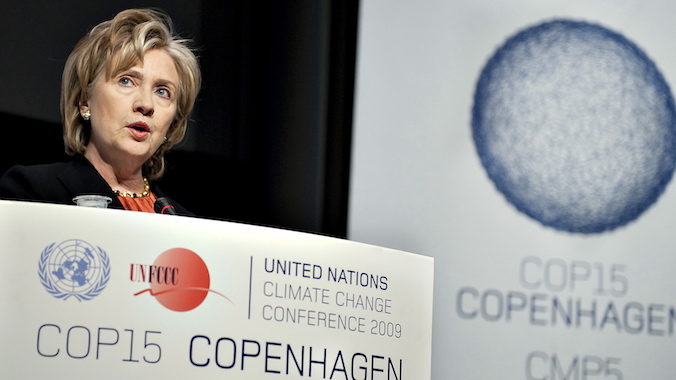Rich Countries Were Never Going to Make This Easy
Photo by Henning Bagger/EPA/Shutterstock
In December 2009, then-Secretary of State Hilary Clinton was in Copenhagen, trying to salvage a floundering COP15 U.N. climate conference. At a press conference, she endorsed an idea that would end up as a theoretical cornerstone of global cooperation on the issue: “The U.S. is prepared to work with other countries to jointly mobilize $100 billion a year by 2020,” she said.
That pile of cash was intended to flow from the rich countries of the world to the Global South, in order to help them adapt to the climate change that for the most part they had no hand in causing, and to build up their own infrastructure in clean ways to avoid exacerbating the issue. 2020 came and went: no dice. By 2022 the nice round number appears to have been crossed, though by then it was crystal clear the actual need is more in the range of trillions rather than billions.
There have been rumblings throughout that 15-year odyssey toward some degree of climate reparations that the actual form of the finance takes a lot of the shine off the idea. On Wednesday, a Reuters report put some numbers on the issue: at least $18 billion in climate loans from rich countries including Japan, Germany, and the U.S. have been issued at market interest rates, rather than at low or no interest as such international aid is generally set, or just in the form of outright grants with no expectation of repayment. What’s more, tens of billions of the money come with requirements that the recipient countries hire companies or purchase materials back from the “donor” country.
Here’s some money to address climate change, now pump it back into our economy instead of yours, and also pay us back with interest. You’re welcome.
It is particularly dark to consider that the $100 billion was a compromise, even in 2009. It was formally proposed in Copenhagen by Ethiopian Prime Minister Meles Zenawi, and the number he chose was seen as far too low. The point, though, was to have some control over how the money was mobilized.
“My proposal dramatically scales back our expectation of the level of funding in return for more reliable funding and a seat at the table in the management of such fund,” he said at the time (emphasis mine). In short, the poorest countries in the world were willing to accept less money if they had a hand in how it arrived; 15 years later, the promise has only belatedly been kept, and that hand in management seems to be waving in the wind.
This is always how it was going to go. Virtually every corner of the climate-money conversation features lofty promises that then turn out to be hiding an iceberg’s worth of crap down below. Take the Glasgow Financial Alliance for Net Zero, a flashy collection of many of the world’s biggest financial institutions from Citi to Blackrock; during the COP26 conference in Scotland it announced that more than 600 member institutions now had more than $130 trillion in “capital committed to net zero.”
Sounds impressive! But a report last year from Reclaim Finance showed that most of the member institutions continued to “pour hundreds of billions of dollars into the expansion of the coal, oil and fossil gas industries,” and only a few had meaningful policies in place meant to stem that flow. Not so hard to sign up for a net-zero pledge if you have no intention of following through.
At the national level, countries will always face home-grown opposition to sending substantial dollar amounts abroad. In 2021, President Biden pledged to increase U.S. climate finance to $11 billion; though a 2023 State Department report suggests the numbers are going up and the pledge might be met soon, Republicans in Congress would likely prefer the number drop to zero, and the odds of international climate finance surviving a second Trump White House are laughable.
And that’s without even considering what might be a fair share of the climate finance pie based on historic contributions to the greenhouse gas blanket around the planet — by some accounting, the U.S. should be paying nearly half of all finance, or over $40 billion if we stick to the compromised $100 billion target.
The debt that poor countries face has become a major issue in climate discussions. Barbados Prime Minister Mia Mottley has been leading the way on the topic, arguing that nations facing the most climate change impacts should have their debt forgiven in order to help end a cycle of poverty that will only worsen as seas rise and other impacts proliferate. “We need to have a different deal for island countries and the poor countries of the world,” she said in February.
The Reuters reporting shows that rich countries are nowhere near the sort of sea change that would actually help the Global South face the coming catastrophe, and the distance between what they say and what they do remains vast. French president Emmanuel Macron has endorsed Mottley’s ideas publicly; but among all major climate donors, France is the worst offender when it comes to offering climate aid as loans rather than grants — 90 percent of its $28 billion in aid are loans.
Macron and Mottley jointly hosted a Summit for a New Global Financing Pact last summer. “Sometimes we’ll sit at conferences like this and say, ‘Yes, we will make this available and that available,’ and we believe you,” South African President Cyril Ramaphosa said at the time. “We believe you, but now … we must now see action flowing from that.”